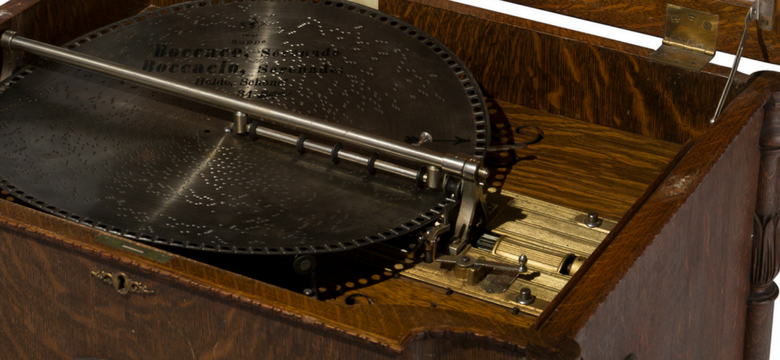Before iPods, before gramophones, before player pianos were the rage, there were parlor music players. Designed for domestic entertainment, a well-appointed home in 1910 likely had one of these. While earlier mechanical players were large, temperamental and expensive (best suited for public spaces), music boxes like this Mira player changed the American parlor and harmonized with our national identity.
A mechanical marvel, the likes of which once was reserved for amusement parks, town squares or the very wealthy, had become democratized. Mira players became part of the lives of many middle-American households – imagine the Kansas City lawyer or the Birmingham, Alabama dentist playing Broadway Rag for his astonished friends after dinner.
Made in Switzerland by Mermod Freres, the Mira model seen here has the well-designed and exquisitely executed mechanism that you expect from the Swiss, where watch- and clock-making is such an art. The development of self-playing music boxes in Europe has its origins in the 16th century, with carillon or glockenspiel bell towers in which a rotating barrel with cogs strikes tuned bells in public squares. In the 18th century, the barrel-and-cog mechanism was miniaturized to strike a tuned steel tooth comb stuck by a small cylinder. Refined through the 19th century, these smaller cylinder players moved from large public spaces into small private ones, some small enough to fit in a gentleman’s pocket.
This Mira player is a superb example of the next innovation, with interchangeable lightweight discs perforated to be struck with pins and able to play complex and long melodies. The best players, like this one, have many interchangeable disks with popular and classic melodies for any occasion. This player has 35 discs with this player with hit tunes like Blue Danube Waltz, William Tell Overture, Bohemian Girl: The Heart Bowed Down and A Hot Time in the Old Town.
Savvy European music box makers saw tremendous potential in the American market where the technical virtuosity of the boxes appealed to the optimism and opulence of the Gilded Age. These boxes were as impressive as any glockenspiel, but on a small scale for domestic use, not a public space.
These music players also whetted the American imagination for the next leap forward, the gramophone. Mira adapted the gramophone to produce Mira Miraphones which are phonograph players of 78 records. Mira evolved to make portable (vinyl) record players though the 1960s.
This Mira music player, housed in a “Golden Oak” case, harmonized with other furniture in a nice turn-of-the 20th– century, Middle-American interior. Sure enough, this music box was purchased in the 1910s by a Chicago, Illinois lady and was handed down to its current owner, a beloved nephew who now lives in Dallas, Texas.
This piece of history is now presented as lot 63087 in Heritage Auctions’ March 10 Fine and Decorative Arts Auction, ready to be enjoyed and cared for by its next owner.
Find more decorative items like this at HA.com
Written by: Rachel Weathers Rachel Weathers, Senior Appraiser at Heritage Auctions, has worked for 25 years with art and antiques in Texas and Louisiana, with a specialization in American 19th-century furniture and Southern paintings. She has handled thousands of objects in her 16 years in the auction business.
